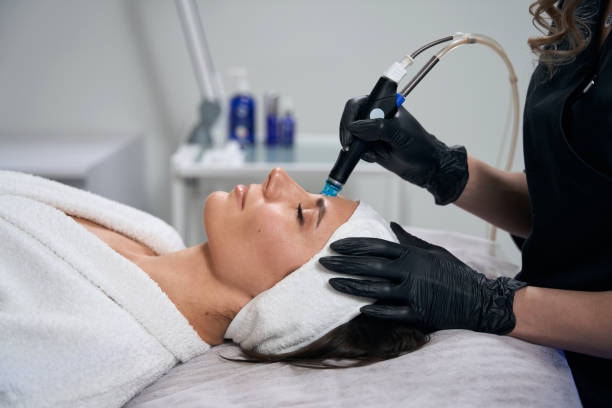Hydrafacial treatments are widely celebrated for their ability to rejuvenate the skin, providing hydration and a fresh glow. However, a common concern among clients is that their Skin Looks Worse After Hydrafacial. If you’ve experienced this, you’re not alone. This article explores the reasons behind this phenomenon and provides expert advice on how to handle it.
Understanding the Hydrafacial Process
Hydrafacial is a multi-step facial treatment that combines cleansing, exfoliation, extraction, hydration, and antioxidant protection. The process is designed to deeply cleanse the skin while delivering essential nutrients. Here’s a quick breakdown of what happens during a Hydrafacial:
- Cleansing: The skin is thoroughly cleansed to remove makeup and impurities.
- Exfoliation: A gentle exfoliating serum is applied to slough off dead skin cells.
- Extraction: A vacuum-like suction is used to remove dirt and debris from pores.
- Hydration: A hydrating serum is infused into the skin, providing moisture and nutrients.
- Protection: An antioxidant-rich serum is applied to protect the skin from environmental damage.
While this treatment is beneficial for many, it can also lead to the concern: why does skin look worse after Hydrafacial?
Common Reasons Skin Looks Worse After Hydrafacial
Several factors can contribute to why your skin looks worse after a Hydrafacial. Understanding these can help you address the issue effectively.
1. Temporary Inflammation
After a Hydrafacial, it’s normal for some clients to experience temporary redness or inflammation. This reaction can be particularly pronounced for those with sensitive skin or pre-existing conditions. While this should subside within a few hours, it may cause the skin to appear worse initially.
2. Allergic Reactions
Some clients may have allergic reactions to specific ingredients used in the Hydrafacial serums. If your skin looks worse after the treatment, it could be due to a reaction to one or more of these products. Common allergens include fragrances and certain preservatives. Always inform your aesthetician of any known allergies before the treatment.
3. Improper Aftercare
Aftercare plays a critical role in how your skin responds post-treatment. If you fail to follow the recommended aftercare guidelines, such as avoiding sun exposure or using harsh skincare products, your skin might react negatively. For optimal results, adhere to the aftercare advice provided by your skincare professional.
4. Existing Skin Conditions
Individuals with existing skin issues, such as acne or rosacea, may find that their conditions flare up post-Hydrafacial. While the treatment aims to improve skin texture, it can sometimes exacerbate underlying issues. If you have a history of skin concerns, consult with a dermatologist before undergoing the treatment.
5. Over-extraction
Hydrafacial’s extraction process can sometimes be too aggressive for certain skin types. If too much debris is removed, it can lead to irritation and make the skin appear worse. Choosing a qualified practitioner who understands your skin type is crucial to prevent over-extraction.
Expert Tips for Managing Post-Hydrafacial Reactions
If you find yourself wondering why your skin looks worse after Hydrafacial, here are some expert tips to help manage and improve your skin's condition.
Stay Hydrated
Hydration is key to recovering from any facial treatment. Drink plenty of water to help your skin regain its moisture balance. Hydration also aids in the healing process, making it easier for your skin to recover from any temporary redness or irritation.
Use Gentle Skincare Products
After a Hydrafacial, your skin may be sensitive. Opt for gentle, fragrance-free skincare products that are free from alcohol and harsh ingredients. Look for calming ingredients such as aloe vera, chamomile, or calendula to soothe the skin.
Avoid Exfoliating Products
Resist the temptation to use exfoliating products for at least a week after your Hydrafacial. Your skin has just undergone a deep exfoliation, and using scrubs or acid-based products too soon can cause further irritation.
Keep It Cool
Applying a cool compress can help soothe inflamed skin. This can reduce redness and discomfort, making your skin feel more comfortable post-treatment. Just be careful not to apply ice directly to the skin—always use a cloth barrier.
Monitor Your Skin
Pay close attention to how your skin responds in the days following your Hydrafacial. If you notice persistent redness, swelling, or discomfort, consult your skincare professional or dermatologist for personalized advice. They may recommend specific treatments to help calm your skin.
When to Seek Professional Help
While many of the post-Hydrafacial reactions are temporary and resolve on their own, some situations warrant a visit to a skincare professional.
Persistent Irritation
If your skin continues to look worse after several days and shows no signs of improvement, it may be time to consult with a dermatologist. They can help determine if you’re experiencing an allergic reaction or another skin issue that needs addressing.
Severe Breakouts
If you experience severe breakouts following your Hydrafacial, it could be a sign that the treatment has exacerbated an underlying condition. A dermatologist can help identify the cause and provide targeted treatment options.
Changes in Skin Texture
If your skin texture changes significantly after the treatment—such as becoming bumpy or developing patches—seek professional advice. A dermatologist can assess your skin and suggest appropriate treatments to restore balance.
Conclusion
While it can be disheartening to see that your skin looks worse after Hydrafacial, understanding the potential causes and how to manage them can make a significant difference. Remember, each person's skin is unique, and reactions can vary. By following expert advice and monitoring your skin closely, you can navigate any post-treatment concerns effectively.





Comments